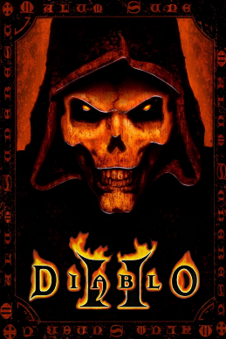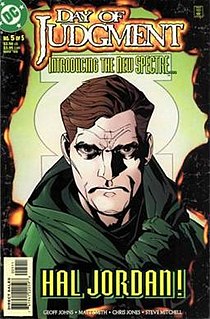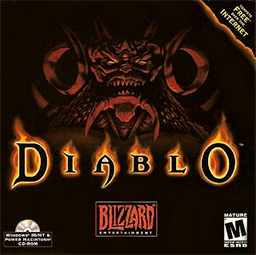Characters of Sanctuary
In the Diablo universe, mortals are born into the world of Sanctuary and are descended from the Nephalem, who were themselves offspring of demons and angels. With such powerful beings as ancestors, these mortals possess great strength, although much of their power was held at bay by the Worldstone, which was shattered by Tyrael at the end of Diablo II: Lord of Destruction .
Adria
Adria (voiced by Lani Minella in Diablo and Alyson Reed in Diablo III) was a mysterious witch that lived on the outskirts of Tristram in the first game. She sold and bought potions, scrolls and staves. She also recharged staves with their magical charges. She was not in Diablo II, having fled Tristram in anticipation of the attack on the village. Adria is the mother of Leah, who was adopted by Deckard Cain after Adria's supposed death. As for what Adria had been doing since the events of the first game and her apparent death, beyond her fleeing of Tristram to the desert jewel of Caldeum, are currently unknown.
In Diablo III, the Nephalem (the player character) finds out that Leah is Adria's estranged daughter. The Nephalem rescues Adria in Caldeum's sewers in Act II, after which she helps the Hero throughout specific portions of the act as well as teaching Leah to control her "power". Adria helps both Leah and the hero trap Belial's and Azmodan's soul in the Black Soulstone, a profane artifact created by the mad Horadric wizard Zoltun Kulle, and is revealed to have prepared the souls of the other Evils, including Diablo himself, to be trapped within the stone as well upon its completion. Adria claims that her purpose for doing this is to destroy all the Evils forever in vengeance for the destruction of Tristram. Unfortunately, when all seven Evils are contained within the Black Soulstone, Adria reveals herself to be pursuing a much darker agenda: she reveals the events of the previous games to all be part of Diablo's master plan to become the Prime Evil, the sum total of all seven Great Evils in one being; Leah's father was Aidan, the warrior son of King Leoric, who was possessed by Diablo after defeating him in the first game. She then unleashes the power of the Black Soulstone upon Leah, turning her into a vessel for Diablo to be reborn as the Prime Evil. Adria then disappears through a portal per Diablo's instruction.
Adria reappears in Reaper of Souls as the second boss of Act V. Myriam Jahzia, the mystic rescued by the Nephalem in Westmarch City, reveals that Adria is searching for Malthael, and thus the Black Soulstone, in order to reclaim it and resurrect her master once more. Despite desiring vengeance for her betrayal, the Nephalem goes to find Adria and discover what she knows of Malthael's location. Encountering her in the ruined city of Corvus, in the Blood Marsh outside Westmarch, the Nephalem witnesses Adria summoning an image of the Pandemonium Fortress, where Malthael is hiding. She then takes on a demonic form with massive wings, and reveals that Diablo granted her a vision of his return, and that the Nephalem would be the one to bring it about. The Nephalem replies that Adria will die alone regardless, and proceeds to kill her. Adria's prophecy was fulfilled shortly after, when Malthael shattered the Black Soulstone and released Diablo's essence during his confrontation with the Nephalem.
Deckard Cain
Deckard Cain the Elder (voiced by Michael Gough) is the only character aside from the title villain, Diablo, to appear in every installment of the series. Through in-game interactions in Diablo, the player learns that Cain is the last surviving member of the original Horadrim, an ancient order of mages charged with trapping the Prime Evils within Soulstones and guarding them thereafter; his ancestor, Jered Cain, had led the party that had pursued and captured Diablo. Cain acts as advisor and guide, accompanying the player's character through each act of the games and providing a great deal of the lore to be found in-game. Despite appearing very old already in Diablo II , Cain returned in Diablo III , which takes place twenty years after the second game, as a somewhat darker character. [15]
Cain remains in Tristram for the entirety of the first game, standing next to the fountain in the middle of town, where he provides his wisdom and identifies items for a small fee. In Diablo II, he is rescued by the player character (or by the Rogues, if the player defeats Andariel without first going to rescue Cain) from a gibbet next to that fountain, and travels with the player throughout; he continues to identify items for the player, but only charges a fee if he is rescued by the Rogues – if rescued by the player, he offers his service free of charge "as a token of my gratitude". In Diablo III, he is rescued from the ruins of Tristram's Cathedral (having fallen into its depths as a result of the "fallen star" impacting the Cathedral in the opening cinematic) as the Skeleton King, reanimated by the "fallen star", sends his guards to attack him. Directing most of the major quests of Act I, Cain is fatally wounded by the witch Maghda and her Dark Coven, who seek the "fallen star" (revealed to be the fallen archangel Tyrael) and his broken sword, recovered by the player. Cain's last act before dying is to use his Horadric magic to reforge the sword, and determine it is angelic in origin. At the cinematic leading into Act II, Cain is cremated on a pyre in the graveyard outside the Cathedral. The player's first quests in Act II involve hunting down Maghda and slaying her as retribution for Cain's death.
Cain gives written and voice narration for a vast number of lore items found in Diablo III, and is also the credited author (narrator) for Blizzard's 2012 book Diablo III: Book of Cain . Cain is also a playable hero in Heroes of the Storm .
Leah
Leah (voiced by Jennifer Hale) is the daughter of Aidan, the Dark Wanderer, and Adria, a powerful witch. She was raised by her adoptive uncle Deckard Cain from the age of eight, as her mother disappeared shortly after giving birth in Caldeum, and her father was supposedly slain while defending Tristram from Diablo. Leah, while interested in her uncle's works, did not share his obsession with demons, secretly believing that his prophecies about the end times coming were just stories. Leah also has an unknown power within her that manifests violently when she is enraged (such as when she sees Cain killed by Maghda); while it is originally established that she cannot control it, when she is reunited with her mother Adria, Leah learns to focus her power, even though it drains her immensely. In the opening of Diablo III, Leah and Cain are in the Tristram Cathedral when a fallen star hits the cathedral, taking Cain with it. Leah refuses to believe he is dead, and recruits the help of a hero to help her find him. After Cain's death, and learning that the fallen "star" was actually the fallen archangel Tyrael, Leah swears to finish what her uncle started and banish all evil from the world.
While in Caldeum, Leah learns that her mother, Adria, is still alive, and rescues her from Caldeum's prisons. With the hero's help, Leah retrieves the Black Soulstone, a powerful artifact, and uses her newly controlled power to seal Belial within the stone. Shortly thereafter, Leah experiences a vision of the last Lord of Hell, Azmodan, and how he plans to invade Sanctuary, capture the Soulstone, and become the Prime Evil, the combination of all the Lords of Hell. However, the powerful hero defeats Azmodan and Leah manages to also seal him inside the Black Soulstone, thus capturing all the seven Lords within the stone. However, Adria betrays Tyrael and Leah, revealing that she had been working for Diablo since he was first sealed inside the stone, and that Leah's extraordinary power comes from her father, revealed to be Diablo himself (when Adria was impregnated by Aidan, who at that time was possessed by Diablo). Adria uses her magic to fuse the six other evils together with Diablo inside the Black Soulstone, and then transfers the single Prime Evil, Diablo, inside Leah, making her his new vessel. After a battle with Imperius at the gate of the High Heavens, Leah's body appears to have been destroyed.
King Leoric
Leoric (voiced by Chris Metzen in Diablo I and Joe J. Thomas in Diablo III) was originally a lord from the eastern lands and a follower of the religion of Zakarum. Some time before the events of the first game, Leoric came to Khanduras and, in the name of Zakarum, declared himself King. Establishing his manor near the decrepit town of Tristram, Leoric brought along his family – his wife, Asylla, and his sons, Aidan and Albrecht – as well as many knights and priests. The people of Khanduras were initially not pleased to be under the rule of a foreign King, but Leoric proved to be a noble and just ruler, earning their respect and adoration.
Unbeknownst to Leoric, the Cathedral of Tristram was where the Horadrim had imprisoned Diablo within his Soulstone centuries before. By the time Leoric arrived in Khanduras, the High Council of the Zakarum had become corrupted by Diablo's elder brother, Mephisto; indeed, Leoric's closest advisor, the Archbishop Lazarus, had been the custodian of Mephisto's Soulstone. Reawakened by Lazarus and seeking a new physical body to inhabit, Diablo sought to possess the strongest soul present: that of Leoric himself. Leoric secretly battled the dark influence hoping his faith would be enough, but Diablo all but destroyed his soul, burning away any vestiges of honor or nobility within him. Though Lazarus stayed close at his side and sought to keep his condition secret, Leoric began to change in both appearance and demeanor, becoming deformed in body and crazed in mind. The people of Khanduras, disheartened by this change in their lord, began to call him "the Black King". Even members of his own family were not immune to his paranoia; Leoric oversaw the beheading of his own wife for perceived treason.
Seeking to remove "meddlesome" members of the King's court, Lazarus convinced the paranoid Leoric that the neighboring Kingdom of Westmarch planned to annex Khanduras. Among the warriors that served in Leoric's army was his eldest son, Aidan. The warriors of Westmarch easily defeated the army of Khanduras, and the survivors returned to find their homeland in total chaos. Diablo had not been able to fully take control of Leoric, a shred of his soul fighting against him still, and so he released the broken King. With the aid of Lazarus, Diablo took possession of Leoric's younger son, Albrecht. Upon learning of Albrecht's kidnapping, Leoric flew into a paranoid rage, declaring the people of Tristram and even the returning warriors to be traitors. With no choice left, Lachdanan, captain of Leoric's army, drew his sword and ran his King through the heart. With his dying breath, Leoric cursed Lachdanan and his warriors. Despite his corruption, Leoric was given a proper burial in a tomb beneath the Cathedral. However, Diablo raised Leoric from his grave to command the legions of skeletons that had begun to rise within the labyrinth; he thus became known as the Skeleton King.
In the first game, Leoric (as the Skeleton King) is a boss in multiplayer games; his tomb is located on level 3 of the labyrinth. When defeated, the Skeleton King drops a powerful helm known as the Undead Crown. During the events of Diablo III, set twenty-two years after the first game, his essence is reanimated by the "fallen star" that crashed through the Cathedral, and is the first major boss fight of the game.
Leoric, in his guise as the Skeleton King, is a playable hero in Heroes of the Storm and in Dota.
Marius
Marius (voiced by Frank Gorshin) is the narrator of the cinematics in the first four acts of Diablo II, and plays a small but vital part of the story of both the main game and Lord of Destruction. He is initially encountered wasting away in a sanitarium when he is visited by a hooded stranger. Believing his visitor to be the Archangel Tyrael, Marius recounts his story, beginning when he resided at the monastery of the Sisterhood of the Sightless Eye in Khanduras until it was overrun by demons. Fleeing to a small tavern, he encountered the Dark Wanderer, who seemed to be a broken man barely able to lift his own sword. But suddenly, power burst from him and burned the tavern to the ground, summoning hellish beasts and skeletons to kill everyone inside – all save for Marius, who inexplicably followed the Wanderer east into the deserts of Aranoch. As they travelled, the Wanderer spoke of his past, telling Marius that he had been a great warrior once and that he now carried a dark burden.
Camping outside the port city of Lut Gholein, Marius slept for the first time in weeks, witnessing a vision of the Horadric mage Tal Rasha being bound in a great tomb in the desert by the Archangel Tyrael, after electing to take the essence of Baal, Lord of Destruction, within himself after the breaking of his Soulstone. When Marius awoke, the Wanderer cryptically stated that he had seen his "brother", and that the Wanderer was seeking him. Locating the Tomb of Tal Rasha, Marius followed the Wanderer inside against his better judgment, where he witnessed the Wanderer attacked by Tyrael before he could remove the Soulstone shard from Tal Rasha's ravaged body. The spirit within the decrepit mage – either Tal Rasha himself or Baal manipulating his "host" – pleaded with Marius to release him, and Marius pulled the Soulstone from Tal Rasha's body. Chastising him for releasing Baal, Tyrael charged Marius to go east to the city of Kurast and enter the Temple of Light, where a gateway to Hell would be waiting, and to take the stone to the great Hellforge to destroy it.
Arriving in Kurast and entering the great temple of the Zakarum, Marius witnessed the dark gathering of the Wanderer, Tal Rasha, and Mephisto, Lord of Hatred. As the three opened the gateway to Hell, the Wanderer shed his mortal form and arose again as Diablo, Lord of Terror. Utterly horrified by what he had seen, Marius could not step through the gate and instead fled, where he eventually ended up in the sanitarium, his body wasting away from the malignant influence of the stone. He heard later that Diablo was defeated, and that his and Mephisto's Soulstones were destroyed at the Hellforge; knowing Baal's had not, he wept and asked for forgiveness. His visitor told Marius to give him the stone, and all would be forgiven, which Marius did gladly. However, the visitor revealed that he was not the Archangel Tyrael, shining the stone towards his face and revealing the ravaged visage of Tal Rasha. Realizing that he had given the stone back to Baal, Marius broke down weeping and babbling before Baal "rewarded" him – killing him with tentacles emerging from his robe, and burning the sanitarium to the ground.
Marius is briefly mentioned by Deckard Cain in Lord of Destruction, who states that if Marius had not intervened, Baal would still be imprisoned within Tal Rasha. He also appears briefly in Act IV of Diablo III, as a vision invoked by Diablo to demoralize Tyrael.
Zoltun Kulle
Zoltun Kulle (voiced by Steven Blum) was a powerful sorcerer who became one of the founding members of the Horadrim centuries before the events of the first game. He worked along with his fellows – including Tal Rasha and Jered Cain – to hunt down the three Prime Evils after their "Dark Exile" to Sanctuary. During the hunt for the Three, Kulle was the custodian of the Soulstones, the artifacts granted to the Horadrim by the Archangel Tyrael to contain the Prime Evils. Kulle became obsessed with the power of the stones; after the Three were contained, he worked to create his own "Black Soulstone", which could contain both angel and demon alike and restore humanity's power to that of the original Nephalem. He created his own Archives in the deserts of Kehjistan to create his Soulstone and experiment on other magi to discover their "Nephalem essence". His fellow Horadrim, fearing that his mad experiments would bring agents of both Heaven and Hell to Sanctuary, confronted Kulle in his sanctum and defeated him, finding that he had become immortal through his experimentations. His head was severed and hidden in the Dahlgur Oasis, and his body contained within a shadow-realm within his Archives. Two vials of his blood, necessary to unlock the gateway to the shadow-realm, were hidden within vaults beneath the Desolate Sands.
Centuries later, during the events of Diablo III, the now-mortal Tyrael – aided by the witch Adria, her daughter Leah, and the new generation of Nephalem – sought to use the Black Soulstone to contain the last two Lords of Hell, Belial and Azmodan, and end their influence once and for all. To do so, they located Kulle's head in the oasis and awakened his spirit. With no option to them, they reluctantly agreed to Kulle's bargain: to restore his living body in exchange for the stone. Locating the vials of his blood, the Nephalem unlocked the shadow-locks and rejoined Kulle's head to his body, and Leah used her power to bring his body back to life. Inside the chamber that contained the Black Soulstone, Kulle realized that the spirits of the other five Lords of Hell – slain by mortal champions years before – had been marked and drawn into the stone (by Adria, it was revealed later, to resurrect Diablo as the Prime Evil), and called the Nephalem to join him in reigning over Sanctuary; the Nephalem refused, and destroyed his body once more. After the defeat of Malthael in Reaper of Souls, in the game's Adventure Mode, Kulle's spirit resurfaces to point the player to Kanai's Cube, an artifact he created as a Horadrim, hidden in the ruins of Sescheron (destroyed by Baal in Diablo II: Lord of Destruction).














